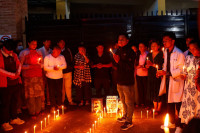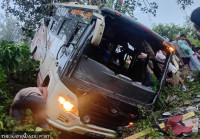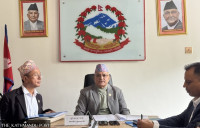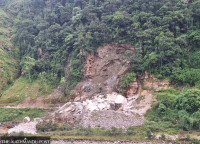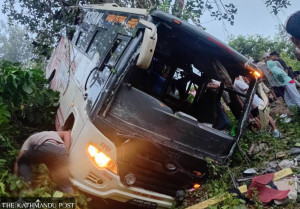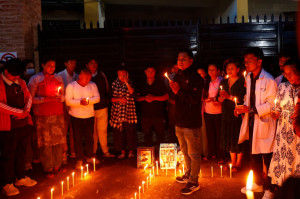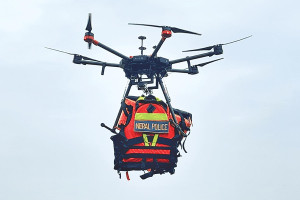Gandaki Province
Delays plague national pride, strategic road projects in Baglung
Despite repeated promises and contract extensions, incomplete roads, stalled bridges, and neglected buildings continue to hinder development in the district.
Prakash Baral
Several road projects, including national pride, and numerous government buildings and bridges in Baglung district have remained unfinished for over a decade, despite multiple contract extensions and repeated political promises.
The projects, meant to boost connectivity and state presence in Nepal’s rugged mid-hill region, have been hampered by delays, contractor negligence, poor oversight, and, in some cases, legal and financial hurdles. Locals say these projects have become little more than slogans during elections.
One key stalled project is a 25-kilometre stretch of the Mid-Hill Highway, a national pride project, between Baglung Bazar and Ghodabandhe. The contract for this segment was awarded in 2014 to Surya Construction and later partially subcontracted to Siddhi Sai-Bharat Joint Venture.
However, repeated deadline extensions yielded little progress. Both contractors eventually abandoned the project, forcing authorities to revoke the contracts. A small portion of the work was attempted by petty subcontractors, but the overall project remains far from completion.
The road segment is vital not only for Baglung district but also for communities in western Nepal, including Rukum East, Rukum West, Jajarkot, Dailekh, Rolpa, and Dolpa.
The road’s condition—dusty in the winter and muddy during the monsoon—has caused extreme hardship for travellers. Landslides frequently block the road, and the completed sections have already deteriorated.
In Galkot Municipality, the roads in wards 1 and 9 are in poor shape. In ward 11, the road has become unsafe after the Darma Khola Hydropower Company allegedly encroached on it.
In many areas, private homes have been built, violating construction standards. Officials say that even after 12 years of work, the project has not been formally mentioned in the Nepal Gazette, leaving it vulnerable to encroachment.
The Baglung-Maldhunga section of the Kaligandaki Corridor faces similar delays. On Thursday, a landslide dislodged rocks that damaged a passing vehicle. For five consecutive years, landslides in the Ekle Sal area have blocked traffic, with no long-term solution identified.
While 60 kilometres of the corridor from Balewa in Baglung to Ridi in Gulmi have been blacktopped, a 10-kilometre segment assigned to Bidari Construction remains incomplete. This has affected travellers from southern Baglung, Gulmi and Palpa who use the route to reach the pilgrimage site of Muktinath. During rainfall, the road becomes impassable. Despite local government interventions, the contractor has not completed the work.
In response to mounting delays, the fourth session of Baglung’s District Assembly has passed a resolution urging the federal government to prioritise and expedite all incomplete projects, especially those related to the Mid-Hill Highway and the Kaligandaki Corridor. Amar Bahadur Thapa, head of the District Coordination Committee, said, “We had to intervene because people have been forced to travel on risky roads for years. We’ve recommended strict action against non-performing contractors.”
Work has also stalled on the Baglung section of the Saljhandi-Dhorpatan road, a vital corridor in western Nepal. Although construction began 16 years ago, most of the 61-kilometre stretch remains incomplete. Much of the track that exists today was opened years ago as a rural road and remains unchanged. Bhimsen Ban, vice-chair of Badigad Rural Municipality, said, “If we proceed with construction, we risk arrears; if we don’t, the public suffers. We’ve appealed to the ministry for action against contractors and for the immediate resumption of work.”
A 22-kilometre section between Burtibang and Dhorpatan is incomplete. A joint contract was awarded in November 2021 to gravel the segment by mid-April 2025. However, only 30 percent of the work has been done so far, most of which has deteriorated due to a lack of maintenance. “Slippery and potholed roads are forcing passengers to take significant risks,” said project chief Gagal Bahadur Bhandari. The financial progress also remains stuck at 30 percent despite a budget of Rs256.1 million.
In its most recent session, the District Assembly designated the Upperla Chaur-Bihun segment of the Mid-Hill Highway, the Saljhandi-Dhorpatan road, and the Kaligandaki Corridor as top priority for immediate intervention.
Other infrastructure projects in the district have suffered the same fate. Administrative buildings in Galkot and Jaimini municipalities are only 50 percent complete, despite deadlines already having expired. Strategic roads such as Kushmisera-Bareyang-Shantipur, Harichaur-Malme-Pandavkhani to Gulmi, Burtibang-Bongadobhan-Sole to Myagdi, and Galkot-Tarakhola to Myagdi are all in limbo. Locals have organised protests demanding the completion of these roads.
Two concrete bridges—one over Darma Khola and another over Bhujikhola—have also been abandoned for years. The District Assembly has flagged all these projects for urgent attention. According to engineer Sagar Bhandari from the Baglung Road Division Office, the works stalled due to contract cancellations, lack of budgetary assurance, legal complications, and absence of technical direction for pending works.
Chitra Bahadur KC, a federal lawmaker from Baglung-1 and a former deputy prime minister, described the condition of national pride projects as “unfortunate.” KC, also chairman of the Rastriya Janamorcha, accused contractors of exploiting state resources for personal gain. “Without strict action against those who abandon contracts, major projects will always be left incomplete,” said KC. He called for stringent punishment for underperforming contractors and rewards for those who deliver.
Meanwhile, delays have begun to draw more public criticism as travellers continue to face hardships and development stagnates across Baglung. For many locals, these projects represent missed opportunities for connectivity, tourism, and economic growth—undermined by poor execution and lack of accountability.




 21.12°C Kathmandu
21.12°C Kathmandu.jpg)
